PONTIAC GRAND-AM 1996 Owners Manual
Manufacturer: PONTIAC, Model Year: 1996, Model line: GRAND-AM, Model: PONTIAC GRAND-AM 1996Pages: 356, PDF Size: 17.17 MB
Page 91 of 356
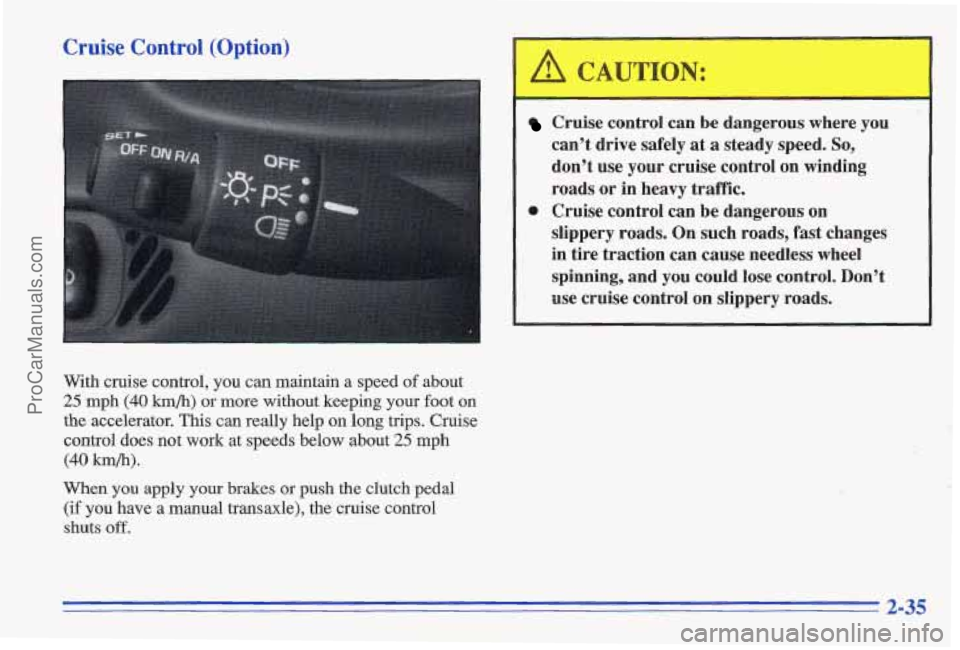
Cruise Control (Option)
With cruise control, you can maintain a speed of about
25 mph (40 h/h) or more without keeping your foot on
the accelerator. This can really help on long trips. Cruise
control does not work at speeds below about
25 mph
(40 hh).
When you apply your brakes or push the clutch pedal
(if you have a manual transaxle), the cruise control
shuts
off.
Cruise control can be dangerous where you
can't drive safely at a steady speed. So,
don't use your cruise control on winding
roads or in heavy traffic.
slippery roads. On such roads, fast changes
in tire traction can cause needless wheel
spinning, and
you could lose control. Don't
use cruise control on slippery roads.
0 Cruise control can be dangerous on
2-35
ProCarManuals.com
Page 92 of 356
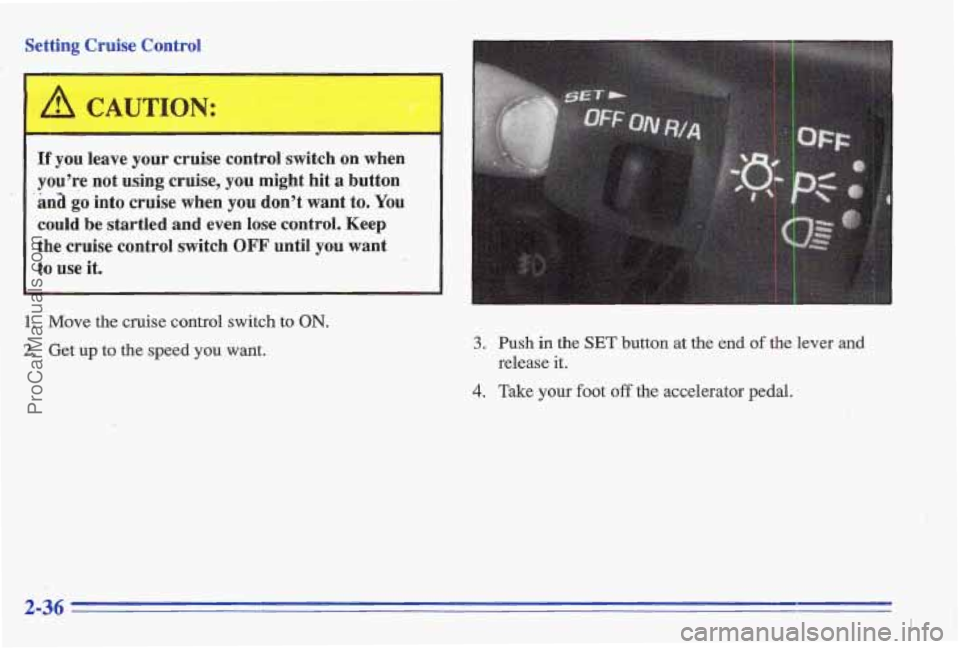
Setting Cruise Control
If you leave your cruise control switch on when
you’re not using cruise,
you might hit a button
ana
go into cruise when you don’t want to. You
could be startled and even lose control. Keep
the cruise control switch OFF until yon want
to
me it.
..
..
1. Move the cruise control switch to ON.
2. Get up to the speed you want. 3. Push in the SET button at
the end of the lever and
release it.
4. Take your foot off the accelerator pedal.
2-36
i
ProCarManuals.com
Page 93 of 356
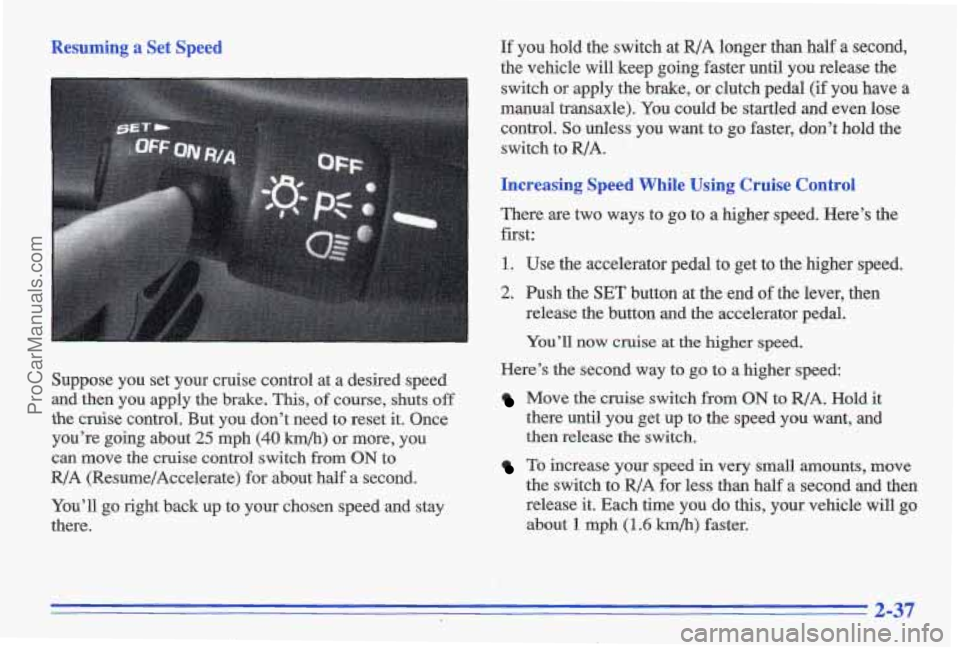
Resuming a Set Speed
I
Suppose you set your cruise control at a desired speed
and then you apply the brake. This,
of course, shuts off
the cruise control. But you don’t need to reset it. Once
you’re going about
25 mph (40 km/h) or more, you
can move the cruise control switch from
ON to
R/A (Resume/Accelerate) for about half
a second.
You’ll go right back up to your chosen speed and stay
there.
If you hold the switch at R/A longer than half a second,
the vehicle will keep going faster until you release the
switch or apply the brake, or clutch pedal
(if you have a
manual transaxle). You could be startled and even lose
control.
So unless you want to go faster, don’t hold the
switch to R/A.
’
Increasing Speed While Using Cruise Control
There are two ways to go to a higher speed. Here’s the
first:
1. Use the accelerator pedal to get to the higher speed.
2. Push the SET button at the end of the lever, then
release the button and the accelerator pedal.
You’ll now cruise
at the higher speed.
Here’s the second way to go to a higher speed:
Move the cruise switch from ON to R/A. Hold it
there until you get up to the speed you want, and
then release the
switch.
To increase your speed in very small amounts, move
the switch to R/A for less than half a second and then
release it. Each time you
do this, your vehicle will go
about 1 mph (1.6 h/h) faster.
2-37
ProCarManuals.com
Page 94 of 356
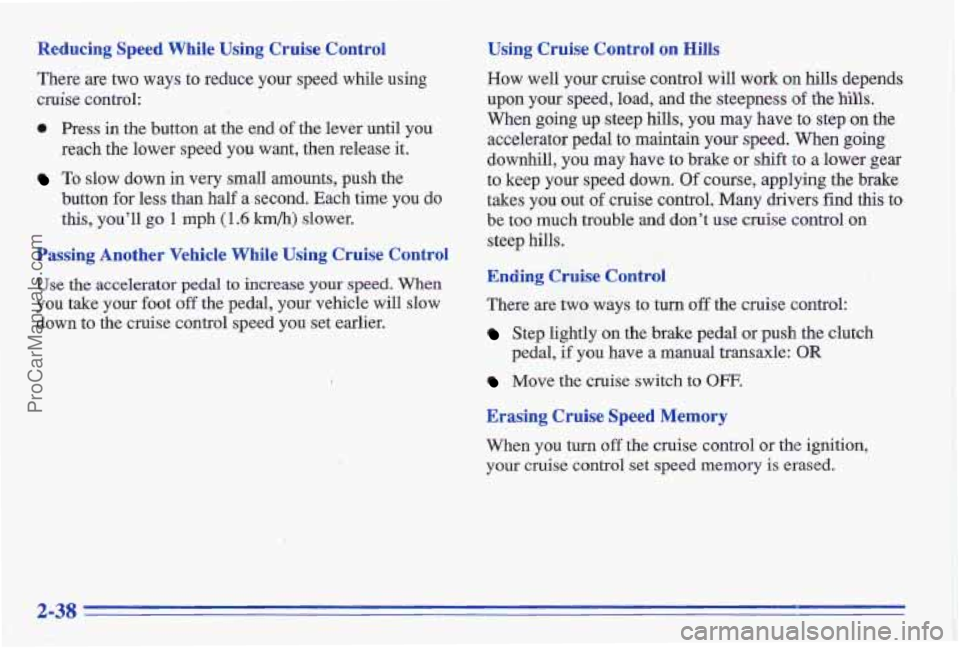
Reducing Speed While Using Cruise Control
There are two ways to reduce your speed while using
cruise control:
0 Press in the button at the end of the lever until you
reach the lower speed you
want, then release it.
To slow down in very small amounts, push the
button
for less than half a second. Each time you do
this, you'I1 go 1 mph (1.6 h/h) slower.
Passing Another Vehicle While Using Cruise Control
Use the accelerator pedal to increase your speed. When
you take your foot
off the pedal, your vehicle will slow
down to the cruise control speed you set earlier.
I'
Using Cruise Control on Hills
How well your cruise control will work on hills depends
upon your speed, load, and the steepness of the bills.
When going up steep hills, you may have to step on the
accelerator pedal to-maintain your speed.
When going
downhill, you may have to brake
or shift to a lower gear
to keep your speed down. Of course, applying the brake
takes
YOU out of cruise control. Many driven find this to;
be too much trouble and don't use cruise control on
steep
hills.
'Ending Cruise Control
There are two ways to turn off the cruise control:
Step lightly on the brake pedal or push the clutch
pedal,
if you have a manual transaxle: OR
Move the cruise switch to OFF.
Erasing Cruise Speed Memory
When you turn off the cruise control or the ignition,
your cruise control set speed memory is erased.
ProCarManuals.com
Page 95 of 356
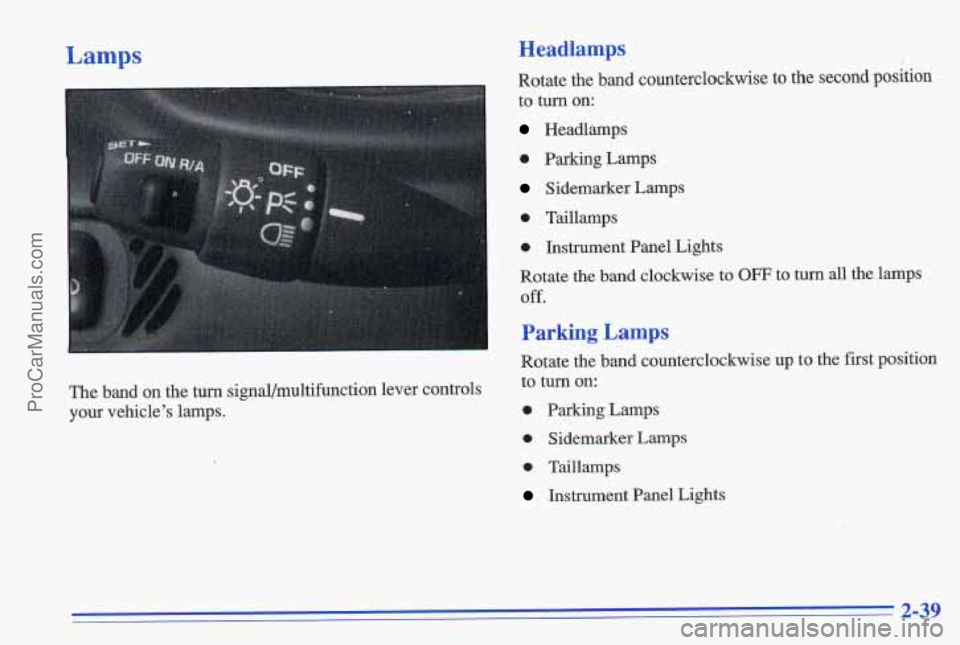
Lamps
I
Headlamps
Rotate the band counterclockwise to the second position
to turn on:
Headlamps
0 Parking Lamps
Sidemarker Lamps
0 Taillamps
0 Instrument Panel Lights
Rotate the
band clockwise to OFF to turn all the lamps
The
band on the turn signal/multifunction lever controls
your vehicle’s lamps. to turn on:
0 Parking Lamps
0 Sidemarker Lamps
0 Taillamps
Instrument Panel
Lights
2-39
ProCarManuals.com
Page 96 of 356
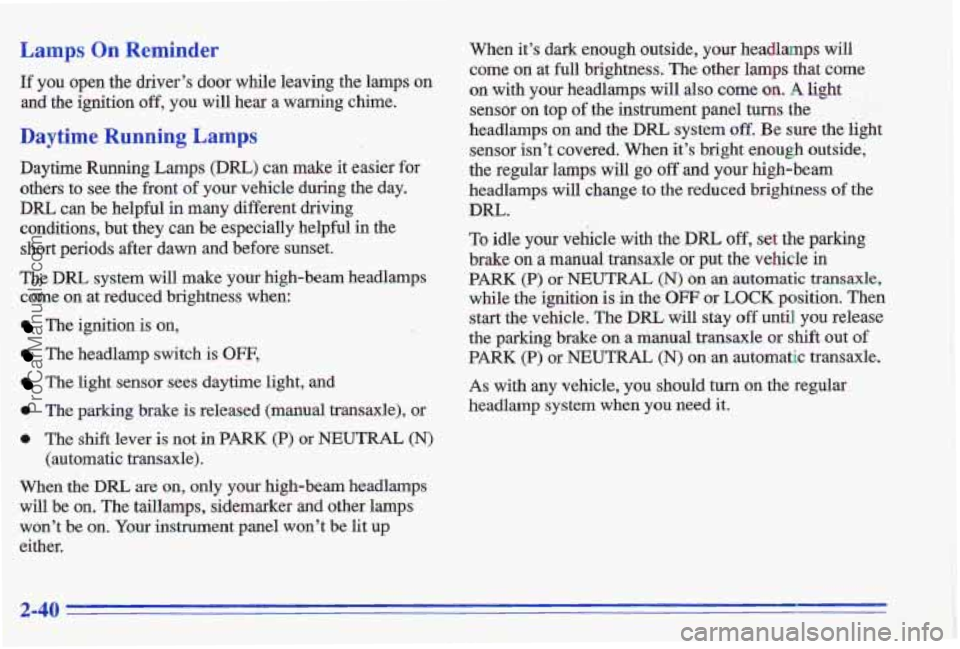
Lamps On Reminder
If you open the driver's door while leaving the lamps on
and the ignition off, you will hear a warning chime.
Daytime Running Lamps
Daytime Running Lamps (DRL) caw make it easier for
others to see the front of
your vehicle during the day.
DRL caw be helpful in many different driving
conditions, but they
can be especially helpful in the
short periods after dawn
and before sunset.
The
DRL system will make your high-beam headlamps
come
on at reduced brightness when:
The ignition is on,
, The headlamp switch is OFF,
The light sensor sees daytime light, and
0 The parking brake is released (manual transaxle), or
0 The shift lever is not in PARK (P) or NEUTRAL (N)
When the DRL are on, only your high-beam headlamps
will
be on. The taillmps, sidemarker and other lamps
won't be on. Your instrument panel wonY be lit up
either. (automatic transaxle). When
it's dark enough outside,
your headlamps will
come on at full brightness.
The other lamps that come
on with your headlamps will also come on. A light
sensor ,on top of the instrument panel turns the
headlamps oh and the DRL ,system off. Be sure the light
sensor isn't covered. When it's bright enough outside,
the regular
lamps will go off and your high-bem
headlamps will change
to the reduced brightness of the
DRL.
To idle your vehicle with the DRL off, set the parking
brake on
a manual transaxle or put the vehicle in
PARK (P) or NEUTRAL (N) on an automatic transaxle,
while the ignition is in the OFF or LOCK position. Then
start the vehicle, The DRL will stay off until you release
the
parking brake on a manual transaxle or shift out of
PARK (P) or NEUTaAL (N) on an automatic transaxle.
As with any vehicle,
you should turn on the regular
headlamp system when you need
it.
ProCarManuals.com
Page 97 of 356
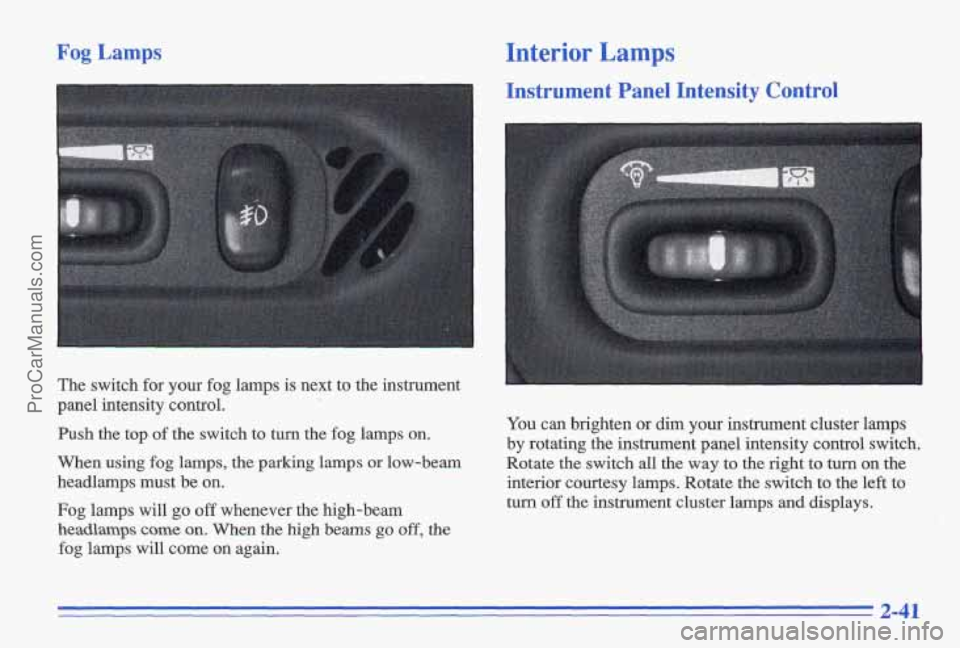
Fog Lamps Interior Lamps
Instrument Panel Intensity Control
The switch for your fog lamps is next to the instrument
panel intensity control.
Push the top of the switch to turn the fog lamps on.
When using fog lamps, the parking lamps or low-beam
headlamps must be on.
Fog lamps will go off whenever the high-beam
headlamps come on. When the high beams go off, the
fog lamps will come on again.
You can brighten or dim your instrument cluster lamps
by rotating the instrument panel intensity control switch.
Rotate the switch all the way
to the right to turn on the
interior courtesy lamps. Rotate the switch to the left to
turn
off the instrument cluster lamps and displays.
2-41
ProCarManuals.com
Page 98 of 356
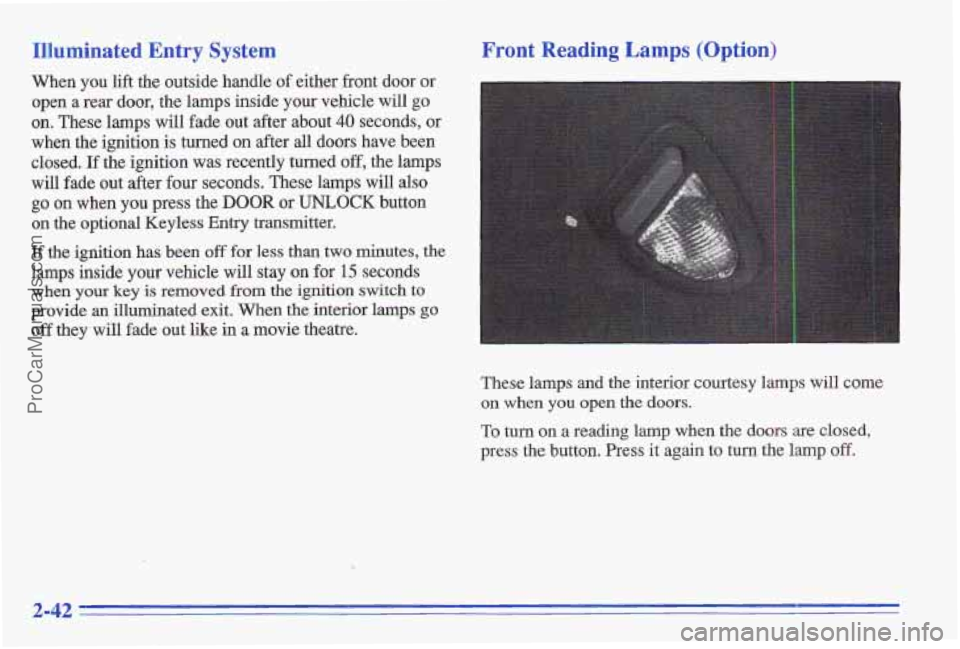
Illuminated Entry System
When you lift the outside handle of either front door or
open a rear door, the lamps inside
your vehicle will go
on. These lamps will fade out after about 40 seconds, or
when the ignition is turned
on after all doors have been
closed. If the ignition was recently turned off, the lamps
will fade out after four seconds. These lamps will also
go on when you press the DOOR or UNLOCK button
on the optional Keyless Entry transmitter.
If the ignition has been off for less than two minutes, the
lamps inside your vehicle will stay on for 15 seconds
when your key is removed from the ignition switch to
provide an illuminated exit. When the, interior lamps go
off they will fade out like in a movie theatre.
Front Reading Lamps (Option)
These lamps and the interior courtesy lamps will come
on when you open the doors.
To turn on a reading lamp when the doors are dosed,
press the button. Press it again to turn the lamp off.
2-42
ProCarManuals.com
Page 99 of 356
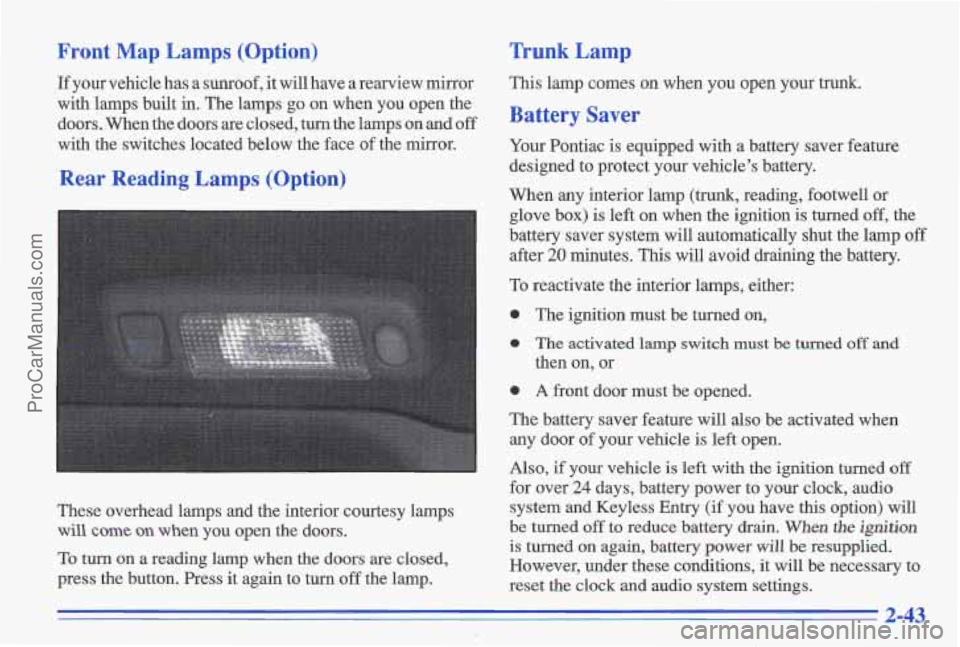
Front Map Lamps (Option)
If your vehicle has a sunroof, it will have a rearview mirror
with lamps built in. The lamps go on when you open the
doors. When the doors
are closed, turn the lamps on and off
with the switches located below the face of the mirror.
Rear Reading Lamps (Option)
These overhead lamps and the interior courtesy lamps
will come on when you open the doors.
To turn on a reading lamp when the doors are closed,
press the button. Press it again-to
turn off the lamp.
Trunk Lamp
This lamp comes on when you open your trunk.
Battery Saver
Your Pontiac is equipped with a battery saver feature
designed to protect your vehicle’s battery.
When any interior lamp (trunk, reading, footwell or glove box) is left
on when the ignition is turned off, the
battery saver system will automatically shut the lamp off
after
20 minutes. This will avoid draining the battery.
To reactivate the interior lamps, either:
0 The ignition must be turned on,
0 The activated lamp switch must be turned off and
then on, or
0 A front door must be opened.
The battery saver feature will also be activated when
any door
of your vehicle is left open.
Also, if your vehicle is left with the ignition turned off
for over
24 days, battery power to your clock, audio
system and Keyless Entry (if you have this option) will
be turned off to reduce battery
drain. When the ignition
is turned on again, battery power will be resupplied.
However, under these conditions, it will be necessary to
reset the clock and audio system settings.
2-43
ProCarManuals.com
Page 100 of 356
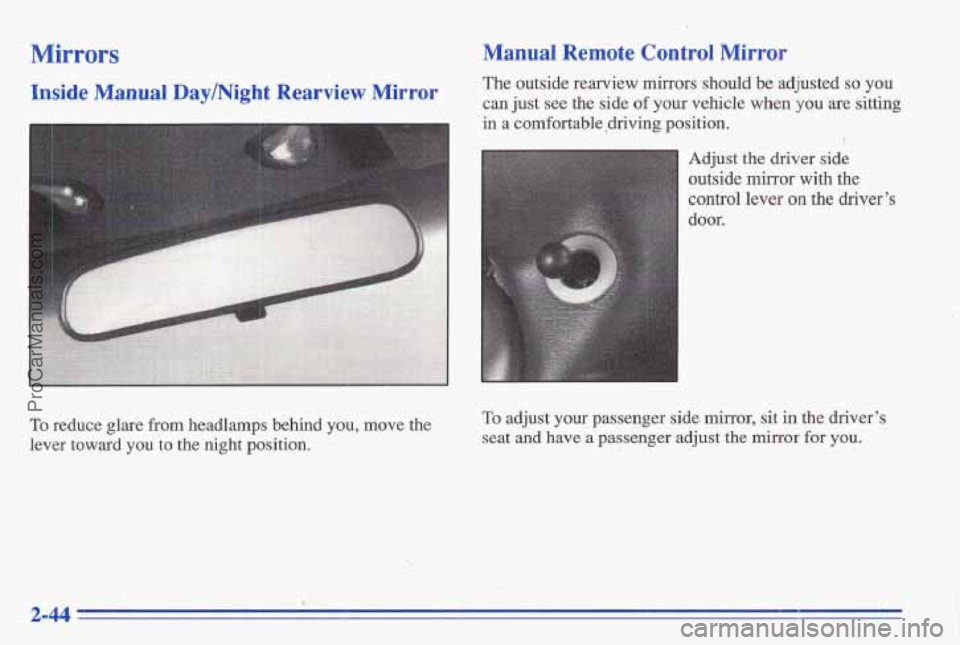
Mirrors
Inside Manual Day/Night Rearview Mirror
To reduce glare from headlamps behind you, move the
lever toward you to the night position.
Manual Remote ,Control Mirror
The outside rearview mirrors should be adjusted so you
can just see the side of your vehicle when you are sitting
in a comfortable ,driving position.
1
Adjust the driver side
outside
mirror with the
control lever
on the driver’s
door.
To adjust your passenger side mirror, sit in the driver’s
seat and have
a passenger adjust the mirror for you.
ProCarManuals.com